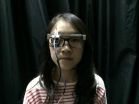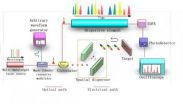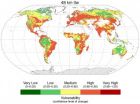(Press-News.org) Researchers using statistical tools to map social connections in prairie dogs have uncovered relationships that escaped traditional observational techniques, shedding light on prairie dog communities that may help limit the spread of bubonic plague and guide future conservation efforts. The work was done by researchers from North Carolina State University and the National Evolutionary Synthesis Center (NESCent).
"Prairie dogs are increasingly rare and are subject to bubonic plague," says Dr. Jennifer Verdolin, lead author of a paper on the work and an animal behavior researcher at NESCent. "This work improves our understanding of the social dynamics within a prairie dog colony, which could help us find ways to mitigate the spread of plague. It also helps us understand how these social groups are connected, so we can limit the disruption to prairie dog populations when we need to relocate them for conservation purposes."
"This project also emphasizes how useful social network theory can be when applied to population biology," says Amanda Traud, co-author of the paper and a Ph.D. candidate in biomathematics at NC State. "And we also developed new tools for this project that can be applied elsewhere and help us use social network theory more effectively to study other species.
"For example, we developed new code that can identify individuals that serve as 'hubs' or 'bridges,' connecting different groups within a population," Traud says.
The researchers used data Verdolin collected on three Gunnison's prairie dog (Cynomys gunnisoni) colonies in Arizona, ranging in size from 60 to 200 individuals. Each colony is made up of numerous, smaller social groups that can consist of up to 15 individuals.
Traud developed statistical tools using social network theory to analyze one year's worth of data on the three colonies, focusing specifically on "greet kissing," in which prairie dogs briefly lock teeth with each other. If individuals are from the same social group, they part amicably. If they are from different groups, they usually fight or chase one another after greet kissing.
By looking at data on greet kissing, Traud established which prairie dogs were in the same group. These groups were consistent with the groups Verdolin had determined, using conventional observational methods of behavior and location.
However, the math-driven social network theory approach also identified substructures within those social groups and key "bridge" individuals that connected different groups – findings that may have significant conservation applications.
"For example, there's a possibility that we could slow or stop the spread of plague in a colony by relocating these bridge individuals," Traud says.
"By the same token," Verdolin says, "conservationists could use this data to be sure to relocate all of a relevant social group, rather than splitting up groups. That could improve the group's chances of thriving in a new environment."
INFORMATION:The paper, "Key players and hierarchical organization of prairie dog social networks," is published in the journal Ecological Complexity. The paper was co-authored by Dr. Rob Dunn, an associate professor of biological sciences at NC State. The research was supported by NESCent, under grant EF-0905606; NASA, under grant ROSES-NNX09AK22G; the Department of Energy, under grant DE-FG02-08ER64510; and the National Science Foundation, under grant 0953390.
Social network research may boost prairie dog conservation efforts
2014-07-28
ELSE PRESS RELEASES FROM THIS DATE:
Motivation explains disconnect between testing and real-life functioning for seniors
2014-07-28
A psychology researcher at North Carolina State University is proposing a new theory to explain why older adults show declining cognitive ability with age, but don't necessarily show declines in the workplace or daily life. One key appears to be how motivated older adults are to maintain focus on cognitive tasks.
"My research team and I wanted to explain the difference we see in cognitive performance in different settings," says Dr. Tom Hess, a professor of psychology at NC State and author of a paper describing the theory. "For example, laboratory tests almost universally ...
Wearable device for the early detection of common diabetes-related neurological condition
2014-07-28
WASHINGTON, July 28, 2014—A group of researchers in Taiwan has developed a new optical technology that may be able to detect an early complication of diabetes sooner, when it is more easily treated. If the device proves safe and effective in clinical trials, it may pave the way for the early detection and more effective treatment of this complication, called diabetic autonomic neuropathy, which is common among people with both Type 1 and Type 2 diabetes. The condition progressively affects the autonomic nerves controlling vital organs like the heart and gastrointestinal ...
Potential 'universal' blood test for cancer discovered
2014-07-28
Researchers from the University of Bradford, UK, have devised a simple blood test that can be used to diagnose whether people have cancer or not.
The test will enable doctors to rule out cancer in patients presenting with certain symptoms, saving time and preventing costly and unnecessary invasive procedures such as colonoscopies and biopsies being carried out. Alternatively, it could be a useful aid for investigating patients who are suspected of having a cancer that is currently hard to diagnose.
Early results have shown the method gives a high degree of accuracy ...
Gender inequalities in health: A matter of policies
2014-07-28
A new study of the European project SOPHIE has evaluated the relationship between the type of family policies and gender inequalities in health in Europe. The results show that countries with traditional family policies (central and southern Europe) and countries with contradictory policies (Eastern Europe), present higher inequalities in self-perceived health, i.e. women reported poorer health than men. Health inequalities are especially remarkable in Southern Europe countries, where women present a 27% higher risk of having poor health compared to men.
The authors of ...
Serial time-encoded amplified microscopy for ultrafast imaging based on multi-wavelength laser
2014-07-28
Ultrafast real-time optical imaging is an effective and important tool for studying dynamical events, such as shock waves, neural activity, laser surgery and chemical dynamics in living cells. Limited by the frame rate, conventional imaging system such as charge-coupled device (CCD) and complementary metal oxide semiconductor (CMOS) imaging device can not image fast dynamic processes. Last few years, serial time-encoded amplified microscopy (STEAM) technique based on space-frequency mapping combined with frequency-time mapping has been demonstrated as a completely new optical ...
Study finds Europe's habitat and wildlife is vulnerable to climate change
2014-07-28
New research has identified areas of the Earth that are high priorities for conservation in the face of climate change.
Europe is particularly vulnerable, as it has the lowest fraction of its land area, only four per cent, of any continent in 'refugia' – areas of biological diversity that support many species where natural environmental conditions remain relatively constant during times of great environmental change. The refugia that do exist in Europe are mostly in Scandinavia and Scotland.
The biggest refugia are in the Amazon, the Congo basin, the boreal forests ...
Why do dogs smell each other's behinds? Chemical communication explained (video)
2014-07-28
WASHINGTON, July 28, 2014 — Here at Reactions, we ask the tough questions to get to the bottom of the biggest scientific quandaries. In that spirit, this week's video explains why dogs sniff each other's butts. It's a somewhat silly question with a surprisingly complex answer. This behavior is just one of many interesting forms of chemical communication in the animal kingdom. Find out more at http://www.youtube.com/watch?v=PZlJ8XfwiNg.
Subscribe to the series at Reactions YouTube, and follow us on Twitter @ACSreactions to be the first to see our latest videos.
INFORMATION:
The ...
Refrigerator magnets
2014-07-28
CAMBRIDGE, MA -- The magnets cluttering the face of your refrigerator may one day be used as cooling agents, according to a new theory formulated by MIT researchers.
The theory describes the motion of magnons — quasi-particles in magnets that are collective rotations of magnetic moments, or "spins." In addition to the magnetic moments, magnons also conduct heat; from their equations, the MIT researchers found that when exposed to a magnetic field gradient, magnons may be driven to move from one end of a magnet to another, carrying heat with them and producing a cooling ...
Children with disabilities benefit from classroom inclusion
2014-07-28
COLUMBUS, Ohio – The secret to boosting the language skills of preschoolers with disabilities may be to put them in classrooms with typically developing peers, a new study finds.
Researchers found that the average language skills of a child's classmates in the fall significantly predicted the child's language skills in the spring – especially for children with disabilities.
The results support inclusion policies in schools that aim to have students with disabilities in the same classrooms alongside their typically developing peers, said Laura Justice, co-author of the ...
Study shows new link between obesity in the young and the lowering of age of puberty
2014-07-28
A new link has been identified between obesity in childhood and the lowering of the age of puberty.
The research which discovered the link, carried out at Plymouth University Peninsula Schools of Medicine and Dentistry, is published in the Journal of Clinical Endocrinology and Metabolism.
The study focuses on a protein called sex hormone-binding globulin (SHBG), the regulation and role of which in children are poorly defined. SHBG binds to the sex hormones androgen and oestrogen. SHGB levels are initially high in childhood but decline significantly before puberty, in ...




